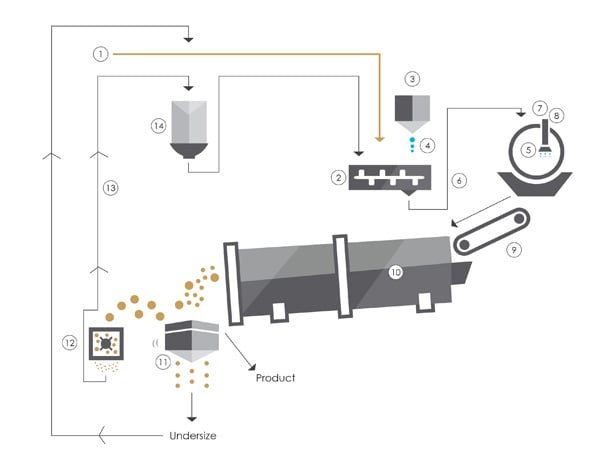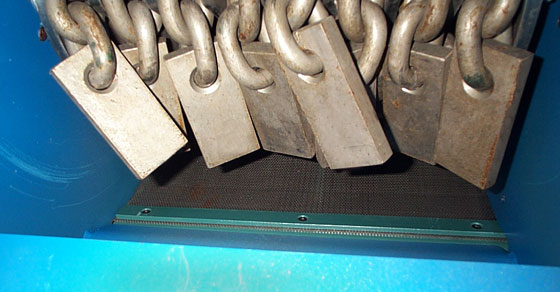Agglomeration processes often rely on the ability to break down oversize material, in order to reach ideal particle size distribution for feedstock, or to put oversize product back into the process as recycle. In order to break down oversize product, size reduction equipment is employed, and while there are a variety of size reduction equipment types available, one option, the hammer mill, offers a reliable size reduction tool for many applications.
Sometimes referred to as crushers, hammer mills provide an efficient solution for breaking down oversize granular materials at a high rate of production, without the use of a grinding action. They are particularly robust and adept at processing demanding materials.
Particle Size Reduction: Why it’s Important
Particle size reduction is most often desirable for one of two reasons: to provide recycle for the process, or to provide the necessary particle size distribution to create a product with the desired characteristics.
Recycle:
After pellets have gone through the process loop, they are typically screened by size, where on-size product is separated out to move on to packaging or shipping, and under- and over-size pellets go back into the process, so they can be processed into on-size pellets, a process referred to as “recycle.” Here, under-size pellets typically go right back to the start of the process loop, but over-size pellets must be broken down before prior to re-entering the process.
Employing a recycle loop aids in minimizing product lost because it was not on-size, making sure as much product is produced as possible.
Some processes require a certain amount of recycle in order to provide a process buffer, should any upsets in the process occur. Having recycle on-hand to put into the process can mean the difference between reliable, continued production of the desired product, or downtime and product lost. In these cases, hammer mills are a key component to operational success, helping to continuously reduce particle size and provide a reliable source of recycle.
Particle Size Distribution:
Often times, in order to achieve the desired end product characteristics, a range in particle size distribution is desirable. This range in particle sizes helps to create a more cohesive pellet or granule, because smaller particles will fill in the spaces between larger ones. A feedstock with too large a particle size would result in a weak pellet, due to the increased amount of void space between particles in the final pellet. In this case, particle size reduction provides the feedstock with the smaller particle size needed to create a pellet of optimum strength.
How Hammer Mills Work
FEECO hammer mills utilize a central rotating shaft, fitted with several “hammers” affixed to pivots on the shaft. As the shaft spins, the hammers are swung via rotational energy, causing them to collide with the material, breaking it up into smaller particles.
Hammer mills are flexible, and can be used in a variety of applications. Because of their heavy-duty construction and high capacity processing capabilities, hammer mills are most commonly utilized in mineral agglomeration and fertilizer production applications.
The diagram below illustrates the placement of a hammer mill in a typical pelletizing process where the hammer mill is used in the breakdown of oversize pellets. In certain low-energy impact situations where the hammer mill is intended to break down raw
material to reach ideal particle size distribution, the hammer mill would simply be placed at the beginning of the process.

- Raw Feed
- Paddle/Pin Mixer
- Binder Feed
- Spray Rate
- Disc Pelletizer
- Feed Onto Pelletizer
- Binder Feed
- Liquid Spray System
- Transfer Conveyor
- Rotary Dryer
- Vibrating Screen
- Oversize/Hammer Mill
- Recycle
- Surge Hopper
In the diagram, you can see that at the screening point, on-size material is separated out, under-size product goes back to the beginning of the process, and over-size product goes through size reduction before it is carried back to the start of the process.
Why A FEECO Hammer Mill?
FEECO’s hammer mills are robust and built for reliable processing in a high capacity setting; with a heavy steel housing, oversized bearings and specially hardened chain hammers, they are built for longevity, despite rigorous processing conditions. In addition to their heavy-duty build, FEECO hammer mills feature a removable quarter panel for easy access and simplified maintenance, as well as a non-clogging design: ample clearance within the machine helps to aid the flow of material, preventing build-up and subsequent downtime.
FEECO has been providing innovative solutions and heavy-duty equipment for over 70 years. In addition to our hammer mills, we also offer clod breakers and cage mills for particle size reduction. For more information on our hammer mills, contact us today.

